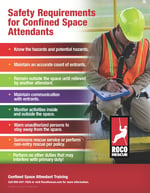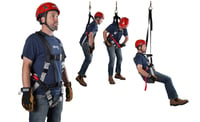Click on the picture below as Roco Chief Instructor Brad Warr discusses recent training at the North Dakota Safety Council's new confined space rescue training prop.

The next training date at NDSC for Roco's Rescue I-Plus course is scheduled for January 8-12, 2018.
Contact the NDSC at 800-932-8890 to register.


 There continues to be a misconception that a confined space attendant (or “hole watch”) is a menial task to be assigned to the greenest, most inexperienced personnel on the job. That’s a dangerous assumption, and it has been a contributing factor in many confined space fatalities.
There continues to be a misconception that a confined space attendant (or “hole watch”) is a menial task to be assigned to the greenest, most inexperienced personnel on the job. That’s a dangerous assumption, and it has been a contributing factor in many confined space fatalities. Don’t allow unauthorized persons to approach or enter the permit space. If you are unable to warn them away, do order the evacuation of the authorized entrants. Do immediately inform the entry supervisor of the situation.
Don’t allow unauthorized persons to approach or enter the permit space. If you are unable to warn them away, do order the evacuation of the authorized entrants. Do immediately inform the entry supervisor of the situation.

 I then suggest that the team’s training records be reviewed in order to determine what level of training has been completed. I also strongly recommend getting everyone to the same level; especially if your facility is what I refer to as an “island unto itself.” In other words, do you have nearby facilities or other local agencies who can offer additional manpower, equipment, etc. in an emergency – or, are you fairly isolated?
I then suggest that the team’s training records be reviewed in order to determine what level of training has been completed. I also strongly recommend getting everyone to the same level; especially if your facility is what I refer to as an “island unto itself.” In other words, do you have nearby facilities or other local agencies who can offer additional manpower, equipment, etc. in an emergency – or, are you fairly isolated? 

 We all know that initial safety training is a crucial element of our programs that aim to keep our employees protected from harm at work. For any and all hazards (or potential hazards} to which we expose our workers, we must ensure they understand the nature of the hazards and how to protect themselves.
We all know that initial safety training is a crucial element of our programs that aim to keep our employees protected from harm at work. For any and all hazards (or potential hazards} to which we expose our workers, we must ensure they understand the nature of the hazards and how to protect themselves. It seems that every week a new piece of fall protection equipment is brought to market – and for the most part, these emerging technologies make work-at-height safer than ever before. Additionally, these newer fall protection items tend to be lighter, more comfortable, easier to operate, and can even perform multiple safety functions. This is all great news, but not every item/system is right for the varied situations encountered at our workplaces. But when we do introduce a new piece of fall protection equipment to our workforce, it nearly universally calls for some degree of re-training. The manufacturer’s instructions for use may be a great starting point to satisfy this training, but it is always a good idea to provide some degree of formal training on the equipment, and then document that training.
It seems that every week a new piece of fall protection equipment is brought to market – and for the most part, these emerging technologies make work-at-height safer than ever before. Additionally, these newer fall protection items tend to be lighter, more comfortable, easier to operate, and can even perform multiple safety functions. This is all great news, but not every item/system is right for the varied situations encountered at our workplaces. But when we do introduce a new piece of fall protection equipment to our workforce, it nearly universally calls for some degree of re-training. The manufacturer’s instructions for use may be a great starting point to satisfy this training, but it is always a good idea to provide some degree of formal training on the equipment, and then document that training.
 I think it is a safe assumption to say that we have all sat through classes wondering when and hoping for the class to end. Looking at our watch is one thing, but when we are tapping it to see if it is even still working is a really bad sign. I am not suggesting that educators have to provide entertainment, but there is a demonstrated positive difference in classes delivered by an engaging trainer as compared to a very dull, monotonous trainer.
I think it is a safe assumption to say that we have all sat through classes wondering when and hoping for the class to end. Looking at our watch is one thing, but when we are tapping it to see if it is even still working is a really bad sign. I am not suggesting that educators have to provide entertainment, but there is a demonstrated positive difference in classes delivered by an engaging trainer as compared to a very dull, monotonous trainer.


